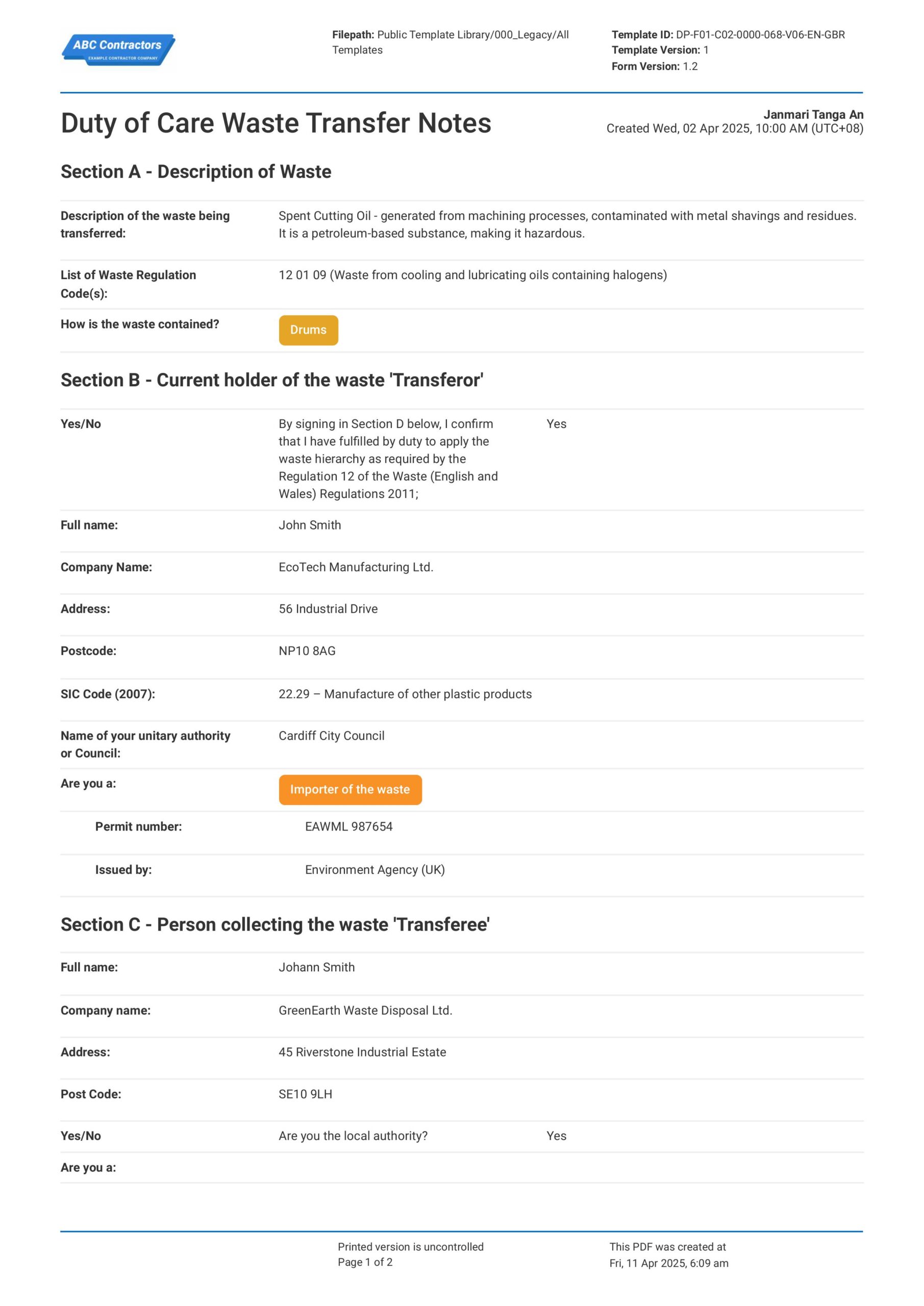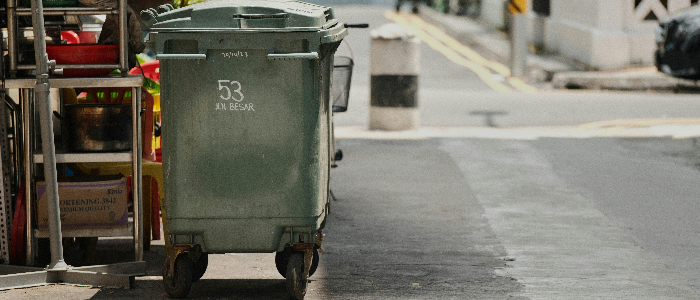Duty of Care Waste Transfer Note Template and Example Form
Start with a free 30-day trial. No credit card required.

~10,000 employees
~500 employees
~25,000 employees
~20 employees
~50 employees
~1,500 employees
~20 employees
What is a Duty of Care Waste Transfer Note?
Businesses in Europe are obligated to clean up and dispose of the waste they generate to ensure the safety of their employees and the environment. This legal obligation is known as the duty of care for waste management. If these business facilities lack proper disposal measures and need to dispose of their waste elsewhere, a waste transfer note is required. These documents will guarantee the proper handling of all waste during transport, which fulfils their duty of care.
Compare this digital Duty of Care Note example to other formats
Use this Duty of Care Waste Transfer Note template for free.
More about your Duty of Care Waste Transfers...
Businesses in the UK are obliged by law to keep a waste transfer note, which is a crucial tool for tracking the movement of waste from one place to its ultimate destination (either a suitable disposal site or managed by another company). You must demonstrate that you are properly disposing of your waste, regardless of the sort of company you run. If the local regulatory agency ever audits your waste management practices, you can use the waste transfer notice as proof. To understand better what a waste transfer note is, let's take a look at its purpose.
Duty of Care
This may appear to be a personal value that an individual should cultivate, but in reality, it is a legitimate name for a piece of legislation in the UK. The duty of care mandates that either people or businesses should act with sensible care and avoid causing harm to other people and the environment. Any breach of this legislation could result in legal consequences for people or businesses. Having said this, mismanagement and lack of priority in waste management can seriously put at risk the environment. This is why any waste-generating establishment needs to have a system in place to regulate and properly handle their waste.
Mitigate Impacts to the Environment
Any industrial business can inevitably have some effects on the environment. These establishments must reduce their environmental impact and stop causing more damage. The waste transfer note guarantees proper waste management and provides measures to mitigate any potential impact. Transporting hazardous waste is particularly crucial. These are the wastes that can cause permanent damage and disrupt the ecological biosystems that naturally maintain balance. With those words said, establishments should again look at their duty of care and inculcate the weight of the responsibility to help protect our environment. Consistently caring for the environment provides a future that everyone can still look forward to.
Gather Useful Data
The waste transfer note, when compiled, can be a useful resource for process improvement. You can actually use the gathered data from the compiled transfer notes to identify gaps in your waste transfer process and provide solutions to improve it further. For example, the carrier can look at the routes that they took and see which route provides a shorter travel time to deliver the waste. From there, they can streamline their process by establishing an official route for travel to save consumable resources required for transport. That is only one example of the many pieces of information the relevant parties can use in improving their process. That being said, staying committed to religiously making waste transfer notes can provide some good benefits to companies involved in the waste transfer.
How to Complete a Duty of Care Waste Transfer Note?
Completing the duty of care transfer note is basic. Inside the form, there are only four important sections that the sender, transferor, and transferee need to fill out. The process is also sequential, where the transferor needs to fill out the form first, followed by the transferee. This design ensures the review and approval of the provided details prior to waste transportation. To understand this better, here are the sections of the waste transfer note:
Section A of the Duty of Care Waste Transfer Note: Description of Waste
The transferor fills out the details of the waste in this section. The data found here are the information about the waste being transferred, the waste regulation code (based on the EWC), and the method or material the waste is contained in. The handling of the waste during transportation will rely heavily on all this information. We must ensure that the person providing the information possesses sufficient knowledge about waste. Providing the wrong information could lead to mishandling and negatively impact our environment. Furthermore, mishandling could also lead to legal charges because it directly violates the legislation on the duty of care.
Section B: Current Holder of the Waste ‘Transferor’
This section requires information about the company sending the waste. The details required include the full name of the transferor, the name of the company, the address and postcode of the company, the SIC code of 2007, the unitary authority or council of the area or region, and an affirmation of whether the company sending the waste has used the waste hierarchy. The items found here provide the full accountability of the transferor. It makes sure the details of the company are present, the unitary body is involved, and the measures of containing the waste are provided and double-checked by the unitary body.
Section C: Person Collecting the waste ‘Transferee’
This section provides the carrier's information. The information about the carrier found here is the name of the person who will handle the transportation of waste, the company name of the carrier (usually the unitary authority of the area), and the address and postcode of their base. In this section, the transferee can also double-check whether the information the transferor provided is correct and factual. After confirming, the transferee will then fill up section D, based on the information taken from the previous sections.
Section D: The Transfer
In this section the transferee can provide the details on where the waste is to be transported to. The details required incorporate the following: the dealer or broker who is arranged to receive the waste, the postcode of the dealer, the registration number (establishments that handle waste must be acknowledged by the UK government), and the date and time of transfer. The destination of the waste is greatly dependent on the results of the waste hierarchy, since there are appropriate sectors to handle the waste based on the results. Make sure to always double-check the results of the waste hierarchy.
Duty of Care Waste Transfer Note Legislation
The law pertaining to the duty of care includes provisions for the secure management of waste to safeguard both human health and the quality of the environment. The waste duty of care obligations are outlined in the code of practice, sometimes known as the Code, which provides practical advice on how to fulfil these duties. It is provided in accordance with the duty of care that is outlined in Section 34(1) of the Environmental Protection Act of 1990 (the EPA), which is an act that was passed in 1990. Importing, producing, transporting, storing, treating, disposing of, or controlling particular waste in England or Wales are all activities that fall within the purview of this Code. The Environmental Agency (EA) in England, Natural Resources Wales (NRW) in Wales, and local councils are the entities responsible for regulating duty of care.
Other popular templates you can use and edit for free

Hazardous Waste Transfer Note
Be in conformance with the Northern Ireland Environmental Agency with your waste transfer

Hazardous Waste Consignment Note
Ensure your hazardous waste transfer process is structured and correct

Landfill Checklist
Use this flexible landfill checklist for your general inspections, landfill safety requirements and more.
This smart doc was generated with Dashpivot software
With this digital template by Dashpivot, make sure that no waste transfer note is forgotten or lost when it is being transported from its point of origin to its final destination:
- Edit the permitted personnel to sign on the document
- Fill out and access your forms from mobile, tablet or computer at any time.
- Take photos and videos inside of the waste tracking app to add evidence to your documents.
- Create unique dashboards and charts for waste production and business trash movement automatically.
Sitemate builds best-in-class software tools for built world companies.

